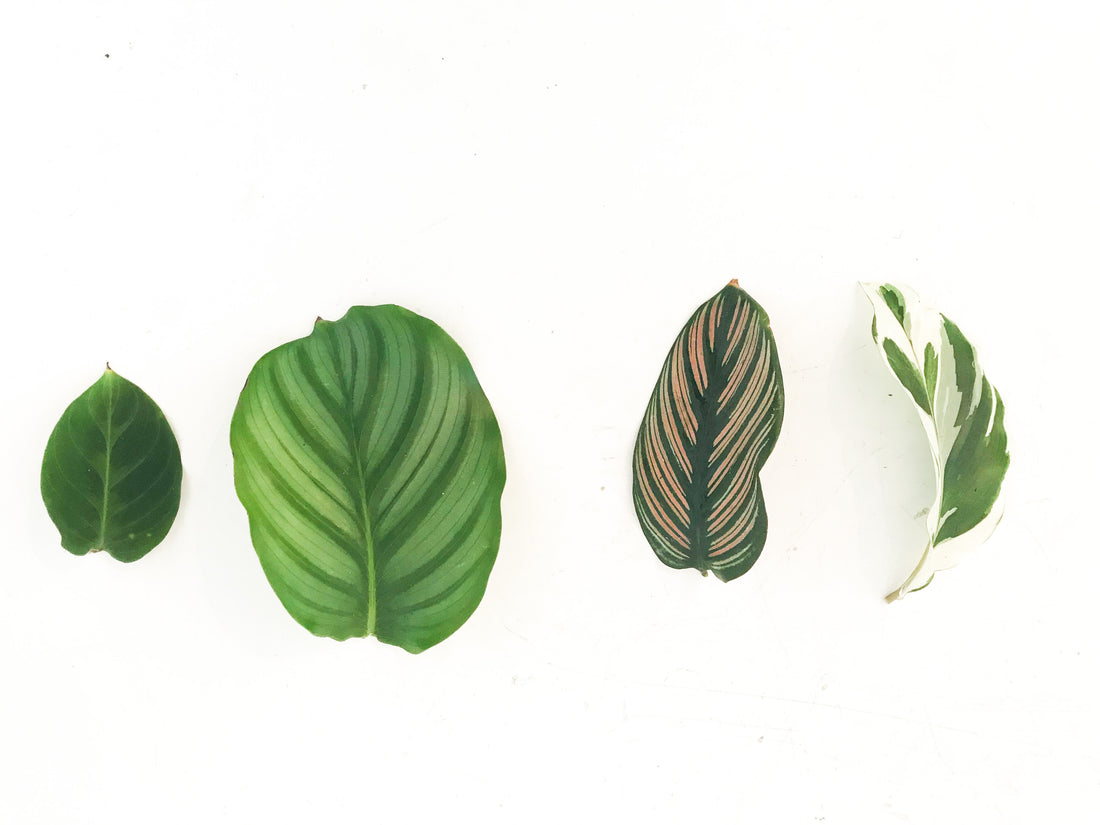For my first article on plant species, I decided to write about Calatheas, my first crush when I launched Miss Boon in 2018.

My mission with Miss Boon has always been to provide you with beautiful plants, each one more original than the other, and especially, than the ones you can't find at the supermarket. I still remember my first visits to my various suppliers in Montreal. My eye was immediately drawn to the magnificent foliage of Calatheas Ornata and Makoyana. Each week, I hoped to find other varieties with even more spectacular foliage.
To this day, the Warzenickzii variety remains my favorite. I never fail to buy White Star and White fusions either. There are also the Orbifolia and Zebrina that I like to feature when they are available. Before I introduce you to these 5 favorites, here's everything you need to know to properly care for these beautiful plants.
This plant with a foliage as beautiful as the plumage of a peacock (hence its other name, the peacock plant), is from the Marantaceae family. Originally (in 1831 to be exact), this plant was identified under the name Geoppertia. It was later renamed Calathea. In 2012, Calatheas reverted to the name Geoppertia, but most people still call them Calatheas. These beauties grace the rainforests of South America, Central America and the West Indies.
To replicate their natural living conditions, you'll want to provide them with a warm climate, free of hot or cold drafts. Hot drafts can cause the edges of the leaves to turn brown or curl up. Cold drafts cause leaves to wilt or turn yellow.
In tropical forests, plants on the ground receive little light. Your plant should not be exposed to the sun at home either. A north-facing window is ideal. Alternatively, you can place your plants at a distance from a window.
The rainforest is very humid! Aim for a humidity level of 50 or 60% to prevent your beauties' foliage from turning brown at the tips or the leaves from curling up on themselves. Plenty of humidity will allow your plant to flourish. Kitchens, bathrooms and basements are naturally more humid than other rooms in the house. A humidifier can also be useful. Finally, for more natural methods, you can group all your plants together (if you have a lot of them) or place them on beds of clay balls covered with water (making sure that the water does not reach the roots of your plants to avoid rotting).
You need to keep the soil slightly moist for your plant to grow well. Also make sure the soil drains well. Some people say that you should only water Calatheas with rainwater. My experience is that this is not necessary (that's also not how they are grown by growers) and that's not how I maintain them at the home-boutique. If your water contains heavy metals, you'll definitely want to get a more natural water, but otherwise Calatheas aren't that fussy.
I use natural fertilizer once a month to stimulate my Calatheas. If you are more of a 20-20-20 type, dilute your mix to 1/4 of what is recommended. Too much fertilizer can burn the foliage of your beautiful plants. If this has happened to you, I suggest rinsing the soil (water the plant in the sink and wait for the water to drain from the holes) to remove excess salt in the soil.
Calatheas go dormant in the winter, but at the home-boutique, they are in a room lit by grow lights (away from them of course) 12 hours a day and I keep the temperature around 26 degrees. This way they continue to produce new leaves, even in January.
Calatheas are often preyed upon by spidermites. At Miss Boon, all Calatheas are treated with a systemic insecticide to prevent such attacks. If you are the type of person who wants to change potting so as to avoid infestations of unwanted plants, you can wait until your plant is too small in its pot to repot it in a mixture of 1 part tropical potting soil, 2 parts peat and 1 part perlite.
That's it! You now have all the tips you need to make your beauties happy. Here are my top 5 most beautiful Calatheas.
1- Calathea Warscewiczii

If only the Web would let you touch this plant, you too would be won over, because its leaves are like velvet. The variety is found in Costa Rica and Nicaragua.
I have a little anecdote to share with you about this plant. Did you know that the artist Jenny Kiker from Living Pattern designed my logo, which I love? The original idea was to make a logo of a Warszewiczii leaf. Logos being what they are, the rendering was not up to what I had in mind for Miss Boon (the rest of the story is that I opted for a Ficus Elastica Ruby leaf for my logo). All this to say that Calathea Warszewiczii holds a special place in my list of the most beautiful plants.
2- Calathea Majestica White Star

My love for the Calathea White Star is purely aesthetic! The gradient from pink to white on a green background is more than spectacular! It is not surprising that this plant is found in a country as colorful as Brazil. By the way, the full name of this plant is Calathea Majestica White Star. It is true that this plant is really majestic!
3 - Calathea White Fusion

Its popularity is certainly due to the fact that variegated plants have been popular for a few years. But its delicate mix of white, mauve and green is enough on its own to explain the popularity of this plant with collectors. It adds an unexpected splash of colour to any green plant assortment.
Calathea White Fusion is a cultivar from a greenhouse in Malaysia. It is certainly the most temperamental of all the Calatheas. Its foliage is particularly delicate and like many variegated plants, the white parts of its foliage are prone to browning. A White Fusion that "reverts" looks like Calathea Misto.
4- Calathea Orbifolia

When I launched Miss Boon in 2018, finding a Calathea Orbifolia was exceptional in Montreal. Only once or twice did I find some at my local suppliers, hidden among their batches of assorted Calatheas! And yes! That was before COVID, when you could go without an appointment to visit the greenhouses. Back then, Instagram fans were already looking for this plant with its beautiful round two-tone foliage from Bolivia. Thankfully, growers (in Florida) went into production in 2020 and now it's relatively easy to find.
5 - Calathea Zebrina

Finally, the other variety of Calathea that you will sometimes find in Miss Boon's trendy plant collection is the Calathea Zebrina, originally from Brazil. Its two-tone zebra foliage is quite spectacular. Unfortunately, this variety does not travel well and some of the leaves are often marked due to handling (you should see how the trucks carrying the plants are loaded...)

